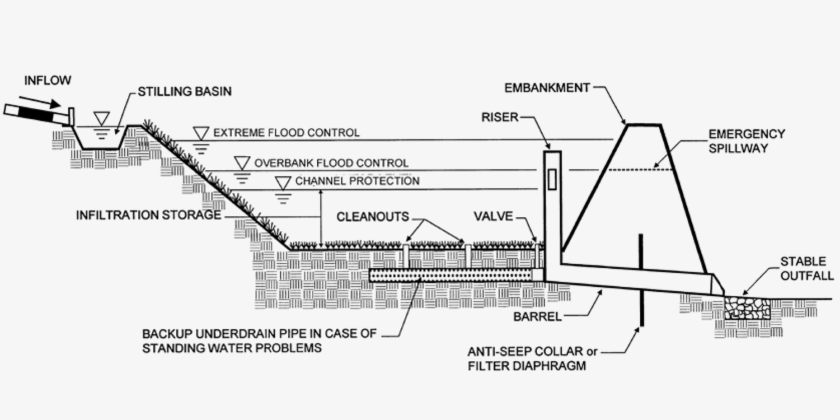Protecting & Restoring Long Island's Peconic Bays

Infiltration systems include basins, porous pavement systems, and infiltration trenches, or wells that are designed to capture stormwater runoff and slow down groundwater infiltration and promote removal of nitrogen through filtration, adsorption, and biological conversion as water drains through the soil (USEPA 1999).
Infiltration basins should be placed at least 100 feet away from any water supply well, cannot be placed upgradient of properties that could suffer flood damage, and should be set back 25 feet downgradient from structures and septic systems (NYS 2015). Stormwater design guidance require that infiltration basins be built on soils with a minimum infiltration rate of 0.5 inches per hour and less than 20% clay, 40% silt/clay, and no fill soils (NYS 2015).
In New York State, stormwater collection systems must follow a five-step process (NYS 2015):
Detailed information on the SPDES permit requirements for SMPs are available on the NYSDEC website at https://www.dec.ny.gov/chemical/8468.html.
The following permits may apply for infiltration basins:
The Suffolk County Water Improvement Division Quality promotes stormwater quality improvements through the Water Quality Protection and Restoration Program and Land Stewardship Initiatives. grant funding program. New York State provides funding through the Water Quality Improvement Project Program.
The nitrogen removal effectiveness of rain gardens varies widely and largely depend on soil type and design coInfiltration basins demonstrate a wide variability in nitrogen removal rates depending on soil type and system design (Simpson and Weammert 2009). Soils with high infiltration rates do not promote nitrogen removal unless they have high organic content (Scheuler 1987). New York State stormwater design guidance require that infiltration basins be built on soils with a minimum infiltration rate of 0.5 inches per hour and less than 20% clay, 40% silt/clay, and no fill soils (NYS 2015). Following additional design principles will help maximize nitrogen removal, including maximizing the surface area of the basin floor, stabilizing inlet channels to avoid scouring and erosion, basin floors that are flat with 30% maximum side slopes to promote vegetation establishment, ensuring soils have adequate organic content, and establishing optimal flushing times (Scheuler 1987).
The percentage of impervious cover (37%) and influent concentration (2.0 mg/L) for infiltration basins considers an The percentage of impervious cover (37%) and influent concentration (2.0 mg/L) for infiltration basins includes an average New York watershed. The removal efficiency range is based on Scheuler (1987) for basins sized to capture a 2-year runoff volume. The drainage area is based on CAST assumptions for an infiltration basin (Chesapeake Bay Program 2020).
Infiltration Basin Nitrogen Effluent Concentrations, Nitrogen Reduction, Drainage Area, and Annual Removal Rates
| BMP | Effluent Nitrogen Concentration (mg/L) | Nitrogen Reduction (%) | Drainage Area (acres) | Annual Nitrogen Removal (lb/yr) |
|---|---|---|---|---|
| Infiltration Basin | 0.6–0.8 | 60–70 | 10 | 51–59 |
Infiltration basin capital costs include construction and design and engineering costs. The lower bound cost is for a new system installed with sand and the upper bound cost is for a retrofit system (with or without sand) and represents the average of system costs included in CAST (Clayton and Schueler 1996; Price et al. 2019; Charles River Watershed Association 2010; Barr Engineering Company 2011; CWP 2007). O&M costs were estimated at 4% to 12% of construction costs. The annualized total cost is on a per acre treated basis by multiplying by the assumed impervious cover percentage (37%) and include capital costs annualized over a 35-year lifespan (average of systems included in the cost estimates) with a 5% discount rate and the annual average O&M cost with a 2% inflation rate applied.
Rain Garden Capital, O&M, Total Annualized Costs, and Costs per Pound of Nitrogen Removed
| BMP Type | Capital Cost | Average Annual O&M Costs | Annualized Total Cost | Cost per Pound N Removed |
|---|---|---|---|---|
| Infiltration Basis | $65,075–$86,416 | $1,844–$4,932 | $3,330–$3,818 | $56–$136 |
Sign up for News, Events and Information straight to your inbox.
